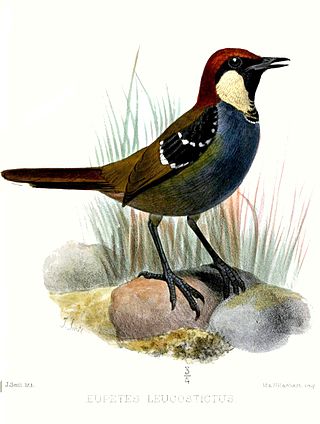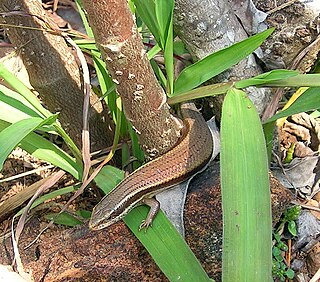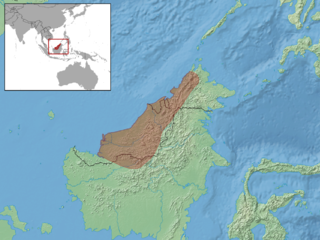
Skinks are lizards belonging to the family Scincidae, a family in the infraorder Scincomorpha. With more than 1,500 described species across 100 different taxonomic genera, the family Scincidae is one of the most diverse families of lizards. Skinks are characterized by their smaller legs in comparison to typical lizards and are found in different habitats except arctic and subarctic regions.

Lamprolepis is a genus of lizards, known commonly as emerald skinks, in the subfamily Lygosominae of the family Scincidae. Lygosoma is its closest genetic relative.

René Primevère Lesson was a French surgeon, naturalist, ornithologist, and herpetologist.

Blue-tongued skinks comprise the Australasian genus Tiliqua, which contains some of the largest members of the skink family (Scincidae). They are commonly called blue-tongued lizards or simply blue-tongues or blueys in Australia or panana in Indonesia. As suggested by these common names, a prominent characteristic of the genus is a large blue tongue that can be bared as bluff-warning to potential enemies. The type of predator/threat that is near will determine the intensity of colour present in the tongue. The tongue can also deform itself and produce a thick mucus in order to catch prey. They are relatively shy in comparison with other lizards, and also significantly slower due to their shorter legs.

The white-breasted wood wren is a small songbird of the wren family. It is a resident breeding species from central Mexico to northeastern Peru and Suriname.
Green tree skink can refer to several skink species:

The white-spotted mannikin is a small passerine bird in the family Estrildidae. It is endemic to southern New Guinea.
Carinascincus palfreymani, known commonly as the Pedra Branca skink, as well as the Palfreyman's window-eyed skink, the Pedra Branca cool-skink, or the red-throated skink, is a species of skink in the family Scincidae. The species is endemic to Australia, and is restricted to the windswept Pedra Branca, an island off southern Tasmania of only 2.5 ha, where it is dependent on the seabird colonies. It is the only lizard species found on the island.

The forest scrub robin is a species of bird in the family Muscicapidae. It is disjunctly present throughout the African tropical rainforest :

The spotted jewel-babbler is a species of bird in the family Cinclosomatidae. It is found in the New Guinea Highlands. Its natural habitat is subtropical or tropical moist montane forests.

Brachythemis is a genus of dragonflies in the family Libellulidae. They are commonly known as groundlings.

Brachythemis leucosticta, the banded groundling or Southern banded groundling, is a species of dragonfly belonging to the family Libellulidae. It is found in Sub-Saharan Africa.

Scincomorpha is an infraorder and clade of lizards including skinks (Scincidae) and their close relatives. These include the living families Cordylidae, Gerrhosauridae, and Xantusiidae, as well as many extinct taxa. Other roughly equivalent terms include the suborder Scinciformata, or the superfamily Scincoidea, though different authors use these terms in a broader or more restricted usage relative to true skinks. They first appear in the fossil record about 170 million years ago, during the Jurassic period.

Lygosominae is the largest subfamily of skinks in the family Scincidae. The subfamily can be divided into a number of genus groups. If the rarely used taxonomic rank of infrafamily is employed, the genus groups would be designated as such, but such a move would require a formal description according to the ICZN standards.

Echinolittorina leucosticta is a species of sea snail, a marine gastropod mollusc in the family Littorinidae, the winkles or periwinkles.
Emerald skink may refer to:
Tree skink is primarily the common name of members of the skink genus Dasia.

Nieuwenhuis's skink is a species of skink. It is found in Borneo.
Dasia vyneri, also known commonly as Shelford's skink and Vyner's tree skink, is a species of lizard in the family Scincidae. The species is native to Southeast Asia.












